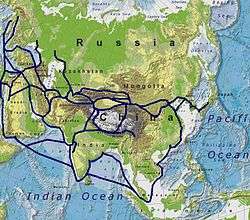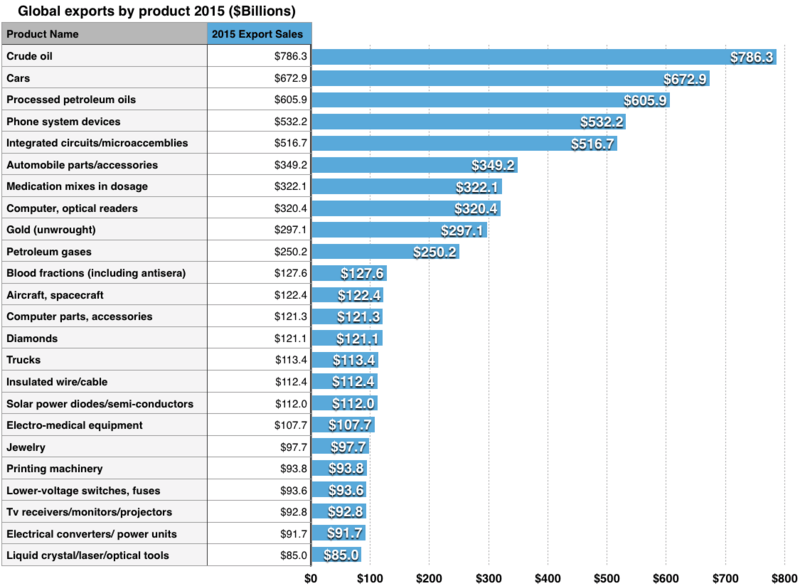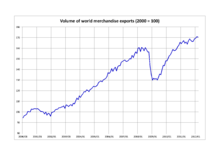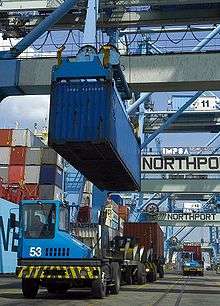International trade
| Part of a series on |
| World trade |
|---|
 |
International trade is the exchange of capital, goods, and services across international borders or territories. It is the exchange of goods and services among nations of the world. [1] In most countries, such trade represents a significant share of gross domestic product (GDP). While international trade has existed throughout history (for example Uttarapatha, Silk Road, Amber Road, salt roads), its economic, social, and political importance has been on the rise in recent centuries.
Characteristic of global trade
Trading globally gives consumers and countries the opportunity to be exposed to new markets and products. Almost every kind of product can be found on the international market: food, clothes, spare parts, oil, jewelry, wine, stocks, currencies and water. Services are also traded: tourism, banking, consulting and transportation. A product that is sold to the global market is an export, and a product that is bought from the global market is an import. Imports and exports are accounted for in a country's current account in the balance of payments.

Industrialization, advanced technology, including transportation, globalization, multinational corporations, and outsourcing are all having a major impact on the international trade system. Increasing international trade is crucial to the continuance of globalization. Without international trade, nations would be limited to the goods and services produced within their own borders. International trade is, in principle, not different from domestic trade as the motivation and the behavior of parties involved in a trade do not change fundamentally regardless of whether trade is across a border or not. The main difference is that international trade is typically more costly than domestic trade. The reason is that a border typically imposes additional costs such as tariffs, time costs due to border delays and costs associated with country differences such as language, the legal system or culture.
Another difference between domestic and international trade is that factors of production such as capital and labor are typically more mobile within a country than across countries. Thus international trade is mostly restricted to trade in goods and services, and only to a lesser extent to trade in capital, labor or other factors of production. Trade in goods and services can serve as a substitute for trade in factors of production. Instead of importing a factor of production, a country can import goods that make intensive use of that factor of production and thus embody it. An example is the import of labor-intensive goods by the United States from China. Instead of importing Chinese labor, the United States imports goods that were produced with Chinese labor. One report in 2010 suggested that international trade was increased when a country hosted a network of immigrants, but the trade effect was weakened when the immigrants became assimilated into their new country.[2]
International trade is also a branch of economics, which, together with international finance, forms the larger branch called international economics.
History
The history of international trade chronicles notable events that have affected the trade between various economies.
Models
There are several models which seek to explain the factors behind international trade, the welfare consequences of trade and the pattern of trade.
Most traded export products

Largest countries by total international trade

Top traded commodities (exports)
| Rank | Commodity | Value in US$('000) | Date of information |
|---|---|---|---|
| 1 | Mineral fuels, oils, distillation products, etc. | $2,183,079,941 | 2012 |
| 2 | Electrical, electronic equipment | $1,833,534,414 | 2012 |
| 3 | Machinery, nuclear reactors, boilers, etc. | $1,763,371,813 | 2012 |
| 4 | Vehicles other than railway | $1,076,830,856 | 2012 |
| 5 | Plastics and articles thereof | $470,226,676 | 2012 |
| 6 | Optical, photo, technical, medical, etc. apparatus | $465,101,524 | 2012 |
| 7 | Pharmaceutical products | $443,596,577 | 2012 |
| 8 | Iron and steel | $379,113,147 | 2012 |
| 9 | Organic chemicals | $377,462,088 | 2012 |
| 10 | Pearls, precious stones, metals, coins, etc. | $348,155,369 | 2012 |
Source: International Trade Centre[3]
See also
- Aggressive legalism
- Comparison of imports vs exports of the United States
- Free trade
- Free trade area
- Gravity model of trade
- Import (international trade)
- International business
- International trade law
- Internationalization
- Market Segmentation Index
- Mercantilism
- Monopolistic competition in international trade
- Trade Adjustment Assistance
- Trade bloc
- Trade finance
- United Nations Conference on Trade and Development (UNCTAD)
- Lists
- List of countries by current account balance
- List of countries by imports
- List of countries by exports
- List of international trade topics
Notes
- ↑ "Trade - Define Trade at Dictionary.com". Dictionary.com.
- ↑ Kusum Mundra (October 18, 2010). "Immigrant Networks and U.S. Bilateral Trade: The Role of Immigrant Income". papers.ssrn. Retrieved 2011-09-01.
Mundra, Kusum, Immigrant Networks and U.S. Bilateral Trade: The Role of Immigrant Income. IZA Discussion Paper No. 5237. Available at SSRN: http://ssrn.com/abstract=1693334 ... this paper finds that the immigrant network effect on trade flows is weakened by the increasing level of immigrant assimilation.
- ↑ International Trade Centre (ITC). "Trade Map - Trade statistics for international business development".
References
- Jones, Ronald W. (1961). "Comparative Advantage and the Theory of Tariffs". The Review of Economic Studies. 28 (3): 161–175. doi:10.2307/2295945.
- McKenzie, Lionel W. (1954). "Specialization and Efficiency in World Production". The Review of Economic Studies. 21 (3): 165–180. doi:10.2307/2295770.
- Samuelson, Paul (2001). "A Ricardo-Sraffa Paradigm Comparing the Gains from Trade in Inputs and Finished Goods". Journal of Economic Literature. 39 (4): 1204–1214. doi:10.1257/jel.39.4.1204.
External links
Data
Official statistics
Data on the value of exports and imports and their quantities often broken down by detailed lists of products are available in statistical collections on international trade published by the statistical services of intergovernmental and supranational organisations and national statistical institutes. The definitions and methodological concepts applied for the various statistical collections on international trade often differ in terms of definition (e.g. special trade vs. general trade) and coverage (reporting thresholds, inclusion of trade in services, estimates for smuggled goods and cross-border provision of illegal services). Metadata providing information on definitions and methods are often published along with the data.
- United Nations Commodity Trade Database
- Trade Map, trade statistics for international business development
- WTO Statistics Portal
- Statistical Portal: OECD
- European Union International Trade in Goods Data
- Food and Agricultural Trade Data by FAO
Other data sources
- Resources for data on trade, including the gravity model
- Asia-Pacific Trade Agreements Database (APTIAD)
- Asia-Pacific Research and Training Network on Trade (ARTNeT)
- International Trade Resources
- World Integrated Trade Solution (WITS)
- Market Access Map, an online database of customs tariffs and market requirements
Other external links
- The Observatory of Economic Complexity
- The McGill Faculty of Law runs a Regional Trade Agreements Database that contains the text of almost all preferential and regional trade agreements in the world. ptas.mcgill.ca
- Historical documents on international trade available on FRASER
